Development of a Complex Vulnerability Index for Fishing Shelters—The Case of Cyprus
Abstract
:1. Introduction
2. Materials and Methods
2.1. Vulnerability Framework
2.2. Study Area (Step 1)
2.3. Development of the Proposed VI (Steps 2 and 5)
2.4. Estimation of the Proposed VI (Step 3 and 5)
| Variable | Vulnerability Levels | |||||
|---|---|---|---|---|---|---|
| Units | Very Low (1/5) | Low (2/5) | Moderate (3/5) | High (4/5) | Very High (5/5) | |
| V1: Mean wind velocity | m/s | [1.80–2.43) | [2.43–3.07) | [3.07–3.70) | [3.70–4.34) | [4.34–4.97] |
| V2: Mean air temperature | °C | [14.29–16.06) | [16.06–17.84) | [17.84–19.61) | [19.61–21.38) | [21.38–23.15] |
| V3: Mean precipitation | mm | [365.69–445.77) | [445.77–525.85) | [525.85–605.93) | [605.93–686.01) | [686.01–766.09] |
| V4: The 1-year return period extreme significant wave height | m | [1.14–1.86) | [1.86–2.59) | [2.59–3.31) | [3.31–4.04) | [4.04–4.76] |
| V5: The 50-year return period extreme significant wave height | m | [2.75–4.19) | [4.19–5.63) | [5.63–7.08) | [7.08–8.52) | [8.52–9.96] |
| V6: Sea level (change) | mm/year | [0–1.27) | [1.27–2.55) | [2.55–3.82) | [3.82–5.10) | [5.10–6.37] |
| V7: Sediment | Type | Boulders (Cobbles) | Pebbles | Sand | Silt | Clay |
| V8: Earthquake zone | I, II, III | Zone I | - | Zone II | - | Zone III |
| V9: Distance from areas included in NATURA 2000 network | km | [9.86–12.32] | [7.39–9.86) | [4.93–7.39) | [2.46–4.93) | [0–2.46) |
| V10: Distance from aquaculture | km | [60.71–75.28] | [46.14–60.71) | [31.56–46.14) | [16.99–31.56) | [2.41–16.99) |
| V11: Harbour capacity | Number of vessels | [7–59) | [59–110) | [110–162) | [162–213) | [213–265] |
| V12: Current usage | % | [47.37–57.32) | [57.32–67.26) | [67.26–77.21) | [77.21–87.15) | [87.15–97.10] |
| V13: Year of construction/reconstruction | Year | [2011–2021] | [2001–2011) | [1990–2001) | [1980–1990) | [1976–1980) |
| V14: Utilities and facilities | Number | [2–3) | [3–5) | [5–7) | [7–9) | [9–10] |
| V15: Port layout | - | [0.12–0.53) | [0.53–0.94) | [0.94–1.35) | [1.35–1.76) | [1.76–2.17] |
| V16: Road network condition | Category | Motorways, two lanes per direction | Main roads, intercity roads, mostly one lane per direction | Secondary road network, mostly connecting rural areas. One paved lane per direction | Local and unclassified roads | Dirt roads |
| V17: Distance from the closest human settlement | km | [0.16–1.04) | [1.04–1.92) | [1.92–2.79) | [2.79–3.67) | [3.67–4.55] |
| V18: Number of inhabitants of the closest human settlement | Number | [448–12755) | [12755–13203) | [13203–25958) | [25958–38713) | [38713–101000) |
| V19: Number of professional users | Number | [6–26) | [26–46) | [46–67) | [67–87) | [87–107] |
| V20: Distance from the closest port | km | [0.17–5.69) | [5.69–11.22) | [11.22–16.74) | [16.74–22.27) | [22.27–27.79] |
| V21: Maintenance costs during the last 15 years (×103) | Euros | [[]660–825 | [495–660) | [330–495) | [165–330) | [0–165) |
2.5. Validation of the Proposed VI (Step 4)
3. Results and Discussion
3.1. Current Vulnerability Assessment
3.2. Site Visits
3.3. Questionnaires
3.4. Interviews
3.5. Future Vulnerability Assessment
4. Conclusions
Author Contributions
Funding
Institutional Review Board Statement
Informed Consent Statement
Data Availability Statement
Conflicts of Interest
References
- IMO. International Shipping Facts and Figures—Information Resources on Trade, Safety, Security, Environment; Maritime Knowledge Centre: London, UK, 2012. [Google Scholar]
- UNCTAD. Key Statistics and Trends in International Trade 2020; UNCTAD: New York, NY, USA, 2021. [Google Scholar]
- IPCC. Climate Change 2001: Impacts, Adaptation, and Vulnerability. Contribution of Working Group II to the Third Assessment Report of the Intergovernmental Panel on Climate Change; Cambridge University Press: Cambridge, UK; New York, NY, USA, 2001. [Google Scholar]
- Izaguirre, C.; Losada, I.J.; Camus, P.; Vigh, J.L.; Stenek, V. Climate Change Risk to Global Port Operations. Nat. Clim. Chang. 2021, 11, 14–20. [Google Scholar] [CrossRef]
- Ng, A.K.Y.; Monios, J.; Zhang, H. Climate Adaptation Management and Institutional Erosion: Insights from a Major Canadian Port. J. Environ. Plan. Manag. 2019, 62, 586–610. [Google Scholar] [CrossRef]
- Ng, A.K.Y.; Zhang, H.; Afenyo, M.; Becker, A.; Cahoon, S.; Chen, S.-l.; Esteban, M.; Ferrari, C.; Lau, Y.-Y.; Lee, P.T.-W.; et al. Port Decision Maker Perceptions on the Effectiveness of Climate Adaptation Actions. Coast. Manag. 2018, 46, 148–175. [Google Scholar] [CrossRef]
- Verschuur, J.; Pant, R.; Koks, E.; Hall, J. A Systemic Risk Framework to Improve the Resilience of Port and Supply-chain Networks to Natural Hazards. Marit. Econ. Logist. 2022, 24, 489–506. [Google Scholar] [CrossRef]
- McIntosh, R.D.; Becker, A. Expert Evaluation of Open-data Indicators of Seaport Vulnerability to Climate and Extreme Weather Impacts for U. S. North Atlantic Ports. Ocean Coast. Manag. 2019, 180, 104911. [Google Scholar] [CrossRef]
- Becker, A.; Chase, N.T.L.; Fischer, M.; Schwegler, B.; Mosher, K. A Method to Estimate Climate-Critical Construction Materials Applied to Seaport Protection. Glob. Environ. Chang. 2016, 40, 125–136. [Google Scholar] [CrossRef]
- PIANC. Climate Change Adaptation Planning for Ports and Inland Waterways, EnviCom WG 178; The World Association for Waterborne Transport Infrastructure: Brussels, Belgium, 2020. [Google Scholar]
- Hinkel, J. “Indicators of Vulnerability and Adaptive Capacity”: Towards a Clarification of the Science–Policy Interface. Glob. Environ. Chang. 2011, 21, 198–208. [Google Scholar] [CrossRef]
- Hinkel, J.; Klein, R.J.T. Integrating Knowledge to Assess Coastal Vulnerability to Sea-level Rise: The Development of the DIVA Tool. Glob. Environ. Chang. 2009, 19, 384–395. [Google Scholar] [CrossRef]
- McLaughlin, S.; Cooper, J.A.G. A Multi-scale Coastal Vulnerability Index: A Tool for Coastal Managers? Environ. Hazards 2010, 9, 233–248. [Google Scholar] [CrossRef]
- Duncan McIntosh, R.; Becker, A. Seaport Climate Vulnerability Assessment at the Multi-port Scale: A Review of Approaches. In Resilience and Risk; Springer: Dordrecht, The Netherlands, 2017; pp. 205–224. [Google Scholar]
- Chhetri, P.; Corcoran, J.; Gekara, V.; Maddox, C.; McEvoy, D. Seaport Resilience to Climate Change: Mapping Vulnerability to Sea-Level Rise. J. Spat. Sci. 2015, 60, 65–78. [Google Scholar] [CrossRef]
- Chapapría, V.E.; Peris, J.S. Vulnerability of Coastal Areas Due to Infrastructure: The Case of Valencia Port (Spain). Land 2021, 10, 1344. [Google Scholar] [CrossRef]
- Yang, Y.-C.; Ge, Y.-E. Adaptation strategies for port infrastructure and facilities under climate change at the Kaohsiung port. Transp. Policy 2020, 97, 232–244. [Google Scholar] [CrossRef]
- Abdelhafez, M.A.; Ellingwood, B.; Mahmoud, H. Vulnerability of Seaports to Hurricanes and Sea Level Rise in a Changing Climate: A Case Study for Mobile, AL. Coast. Eng. 2021, 167, 103884. [Google Scholar] [CrossRef]
- Hanson, S.; Nicholls, R.; Ranger, N.; Hallegatte, S.; Corfee-Morlot, J.; Herweijer, C.; Chateau, J. A global ranking of port cities with high exposure to climate extremes. Clim. Chang. 2011, 104, 89–111. [Google Scholar] [CrossRef]
- Hsieh, C.-H.; Tai, H.-H.; Lee, Y.-N. Port Vulnerability Assessment from the Perspective of Critical Infrastructure Interdependency. Marit. Policy Manag. 2014, 41, 589–606. [Google Scholar] [CrossRef]
- Kontogianni, A.; Damigos, D.; Kyrtzoglou, T.; Tourkolias, C.; Skourtos, M. Development of a composite climate change vulnerability index for small craft harbours. Environ. Hazards 2019, 18, 173–190. [Google Scholar] [CrossRef]
- OECD. The Ocean Economy in 2030; OECD Publishing: Paris, France, 2016. [Google Scholar]
- Jouffray, J.-B.; Blasiak, R.; Norström, A.V.; Österblom, H.; Nyström, M. The Blue Acceleration: The Trajectory of Human Expansion into the Ocean. One Earth 2020, 2, 43–54. [Google Scholar] [CrossRef]
- Yılancı, V.; Kırca, M. Testing the relationship between employment and tourism: A fresh evidence from the ARDL bounds test with sharp and smooth breaks. J. Hosp. Tour. Insights 2023. ahead-of-print. [Google Scholar] [CrossRef]
- Dentale, F.; Furcolo, P.; Pugliese Carratelli, E.; Reale, F.; Contestabile, P.; Tomasicchio, G.R. Extreme Wave Analysis by Integrating Model and Wave Buoy Data. Water 2018, 10, 373. [Google Scholar] [CrossRef]
- Australian Standard. AS 3962—2001: Guidelines for Design of Marinas; Standards Australia: Syndey, Australia, 2001. [Google Scholar]
- Băetu, G.; Gălățanu, T.-F.; Băetu, S.-A. Behavior of Steel Structures under Elevated Temperature. Procedia Eng. 2017, 181, 265–272. [Google Scholar] [CrossRef]
- PIANC. Guidelines for Marina Design. Report No. 149/Part II; PIANC: Brussels, Belgium, 2016. [Google Scholar]
- Kollias, I.; Papadimitriou, A.; Chondros, M.; Chalastani, V.; Spyrou, D.; Laspidou, C.; Koundouri, P.; Tsoukala, V. Assessing the Impact of Climate Change in Wave Agitation for the Port of Piraeus. In Proceedings of the 2nd International Conference, Design and Management of Port, Coastal and Offshore Works, Thessaloniki, Greece, 24–27 May 2023. [Google Scholar]
- Tsoukala, V.K.; Chondros, M.; Kapelonis, Z.G.; Martzikos, N.; Lykou, A.; Belibassakis, K.; Makropoulos, C. An Integrated Wave Modelling Framework for Extreme and Rare Events for Climate Change in Coastal Areas—The Case of Rethymno, Crete. Oceanologia 2016, 58, 71–89. [Google Scholar] [CrossRef]
- Christodoulou, A.; Christidis, P.; Demirel, H. Sea-level rise in ports: A wider focus on impacts. Marit. Econ. Logist. 2019, 21, 482–496. [Google Scholar] [CrossRef]
- Chondros, M.; Metallinos, A.; Papadimitriou, A.; Memos, C.; Tsoukala, V. A Coastal Flood Early-Warning System Based on Offshore Sea State Forecasts and Artificial Neural Networks. J. Mar. Sci. Eng. 2021, 9, 1272. [Google Scholar] [CrossRef]
- Bosa, S.; Petti, M.; Pascolo, S. Improvement in the Sediment Management of a Lagoon Harbor: The Case of Marano Lagunare, Italy. Water 2021, 13, 3074. [Google Scholar] [CrossRef]
- Lam, J.S.L.; Lassa, J.A. Risk assessment framework for exposure of cargo and ports to natural hazards and climate extremes. Marit. Policy Manag. 2017, 44, 1–15. [Google Scholar] [CrossRef]
- Vulnerability of the Sixteen Cypriot Fishing Shelters; Zenodo: Geneve, Switzerland, 2023; Table S1.1. 25 questionsanswered by representatives of professional fishermen in the 16 fishing shelters of the Republic of Cyprus. [CrossRef]
- Landreau, A.; Juhola, S.; Jurgilevich, A.; Räsänen, A. Combining socio-economic and climate projections to assess heat risk. Clim. Chang. 2021, 167, 12. [Google Scholar] [CrossRef]
- Sierra, J.P.; Genius, A.; Lionello, P.; Mestres, M.; Mösso, C.; Marzo, L. Modelling the Impact of Climate Change on Harbour Operability: The Barcelona Port Case Study. Ocean Eng. 2017, 141, 64–78. [Google Scholar] [CrossRef]
- Vanos, J.K.; Baldwin, J.W.; Jay, O.; Ebi, K.L. Simplicity lacks robustness when projecting heat-health outcomes in a changing climate. Nat. Commun. 2020, 11, 6079. [Google Scholar] [CrossRef]
- Jurgilevich, A.; Räsänen, A.; Groundstroem, F.; Juhola, S. A systematic review of dynamics in climate risk and vulnerability assessments. Environ. Res. Lett. 2017, 12, 013002. [Google Scholar] [CrossRef]
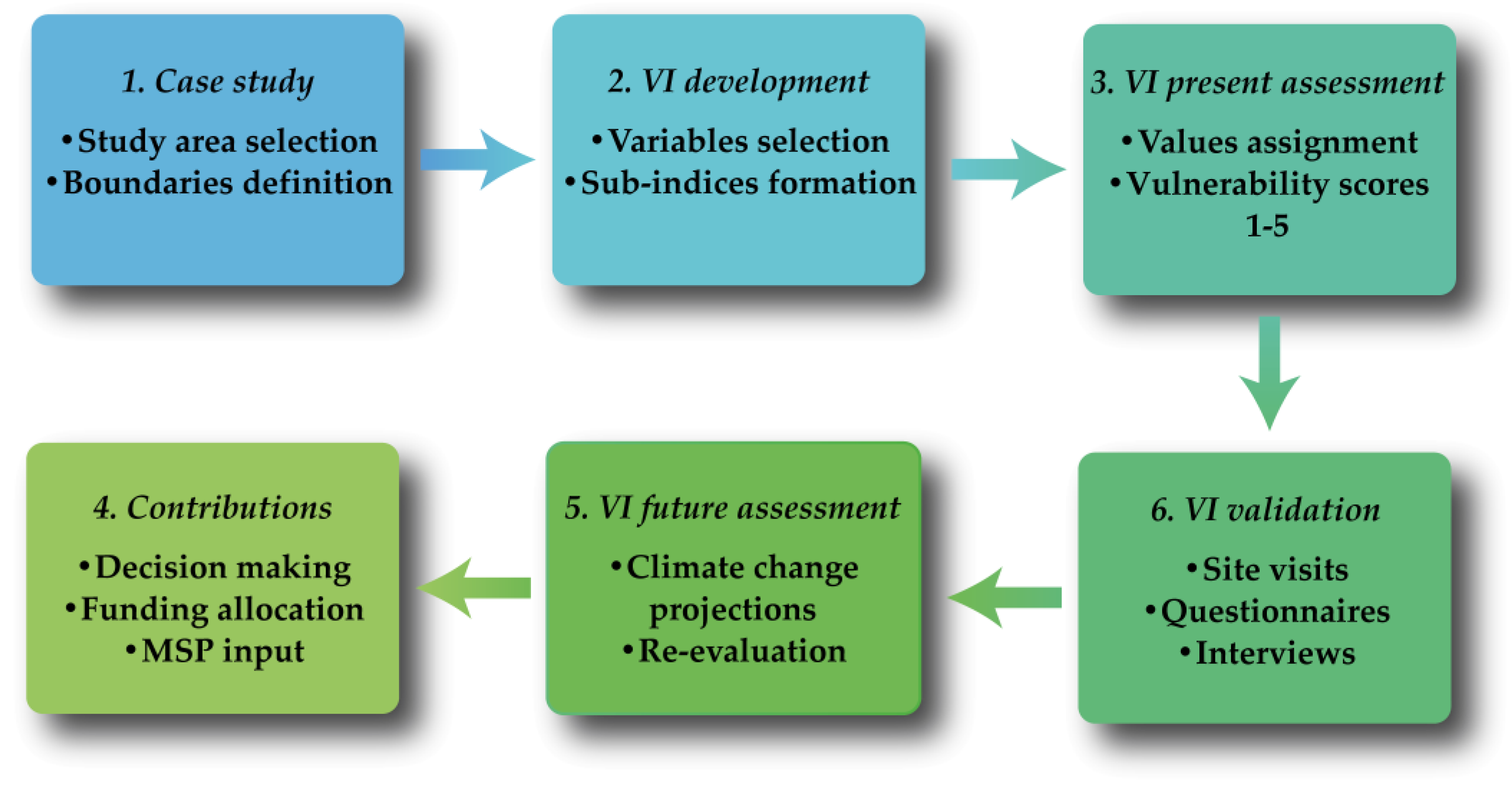


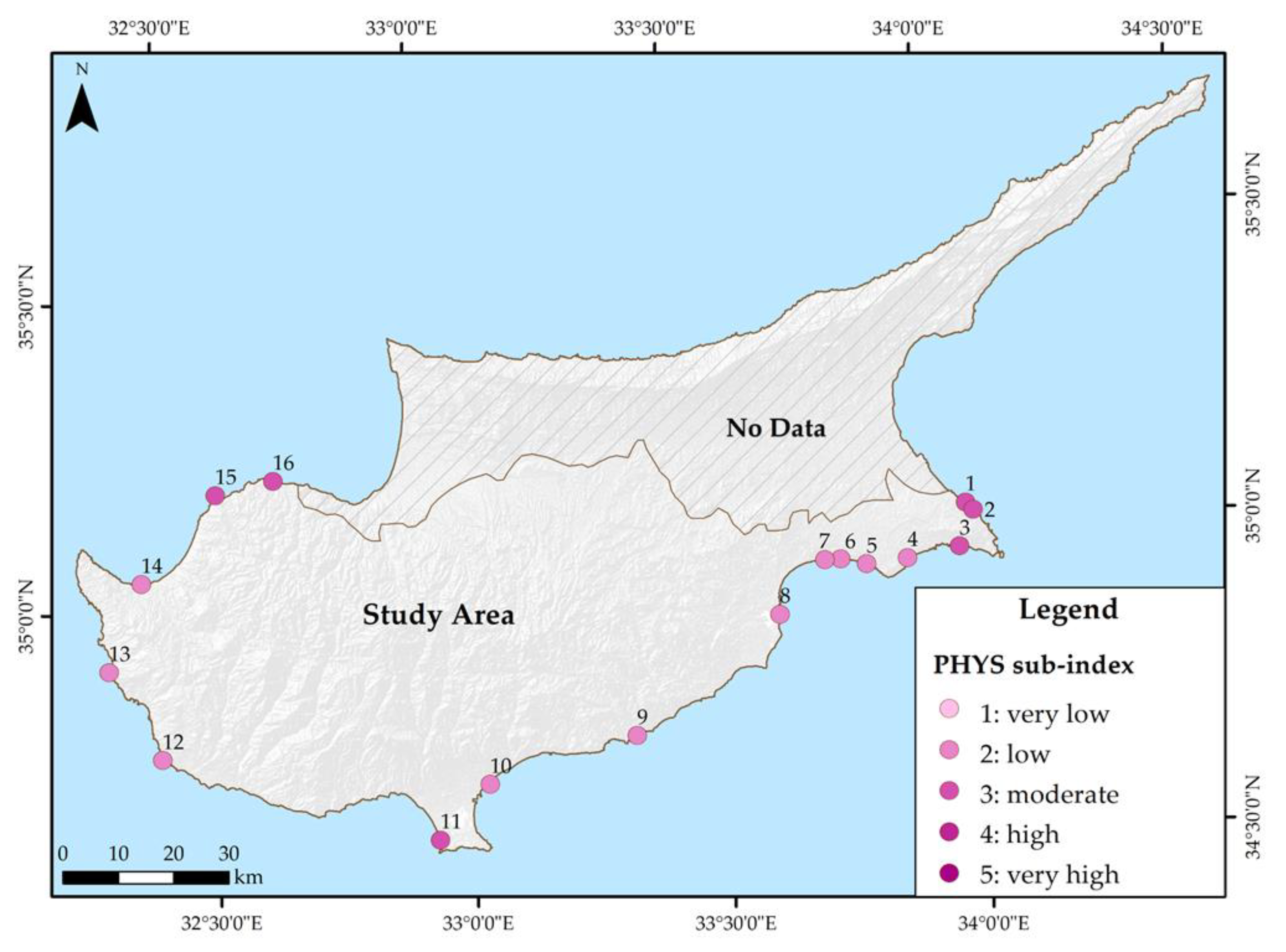
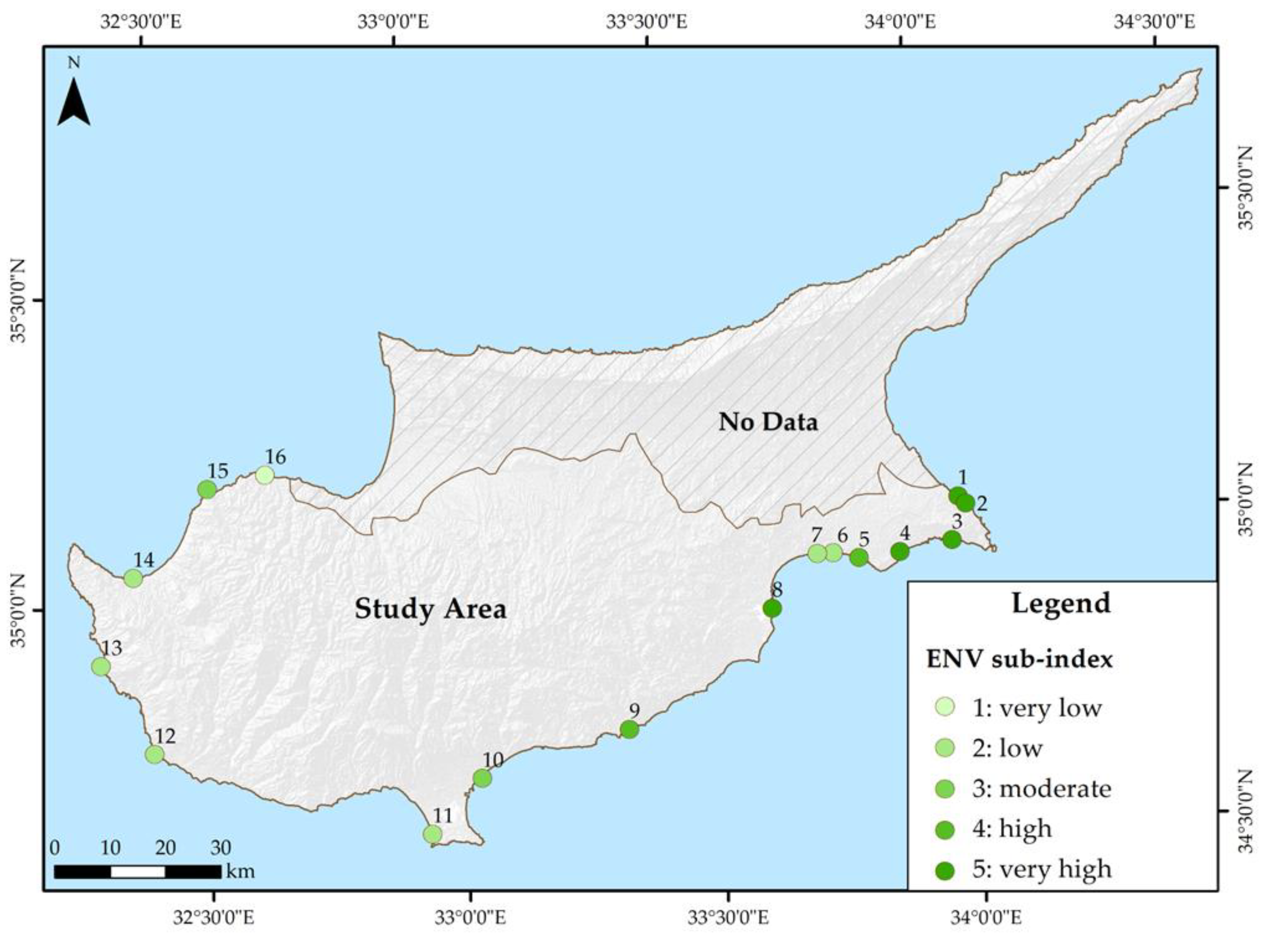

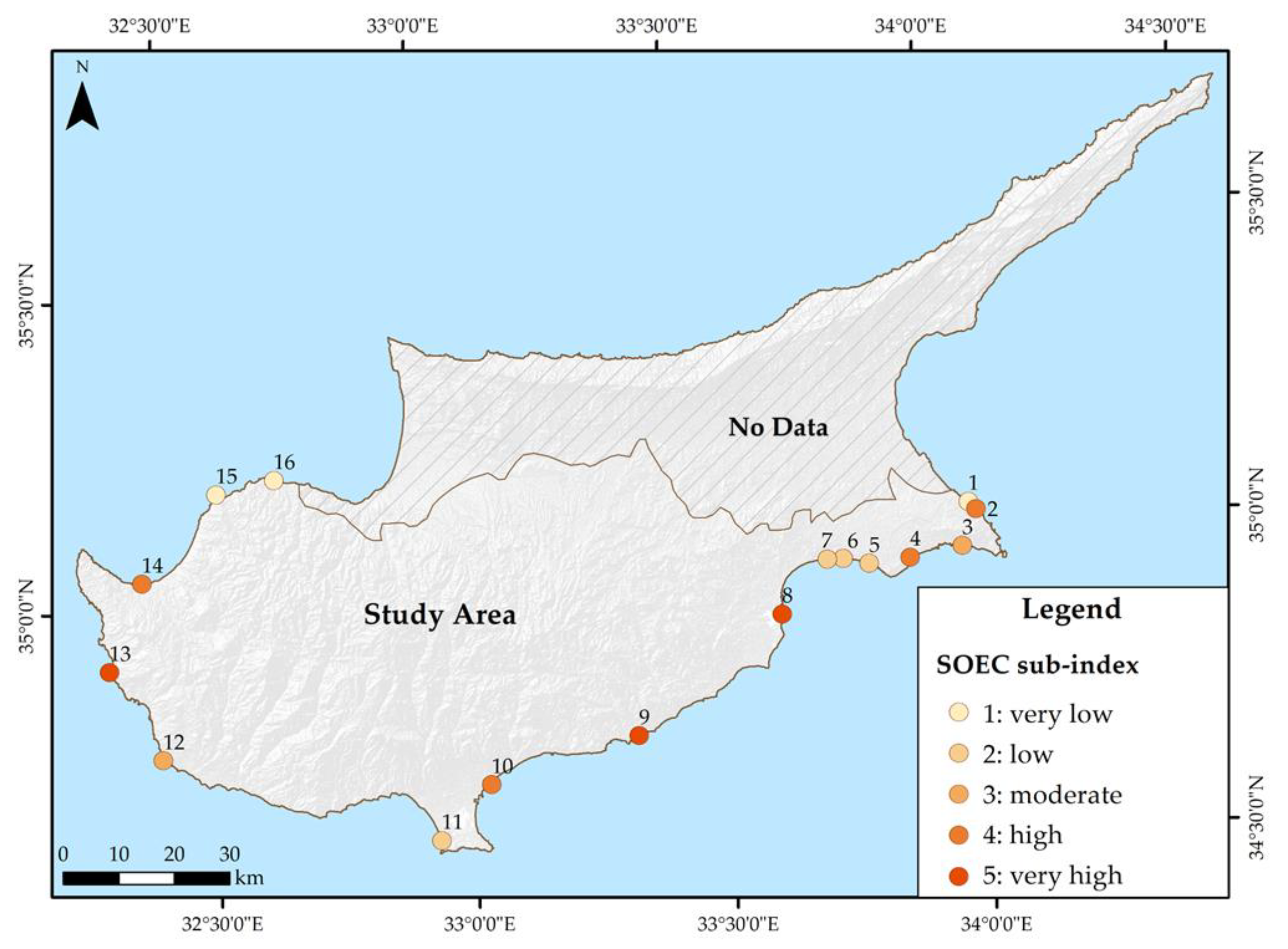
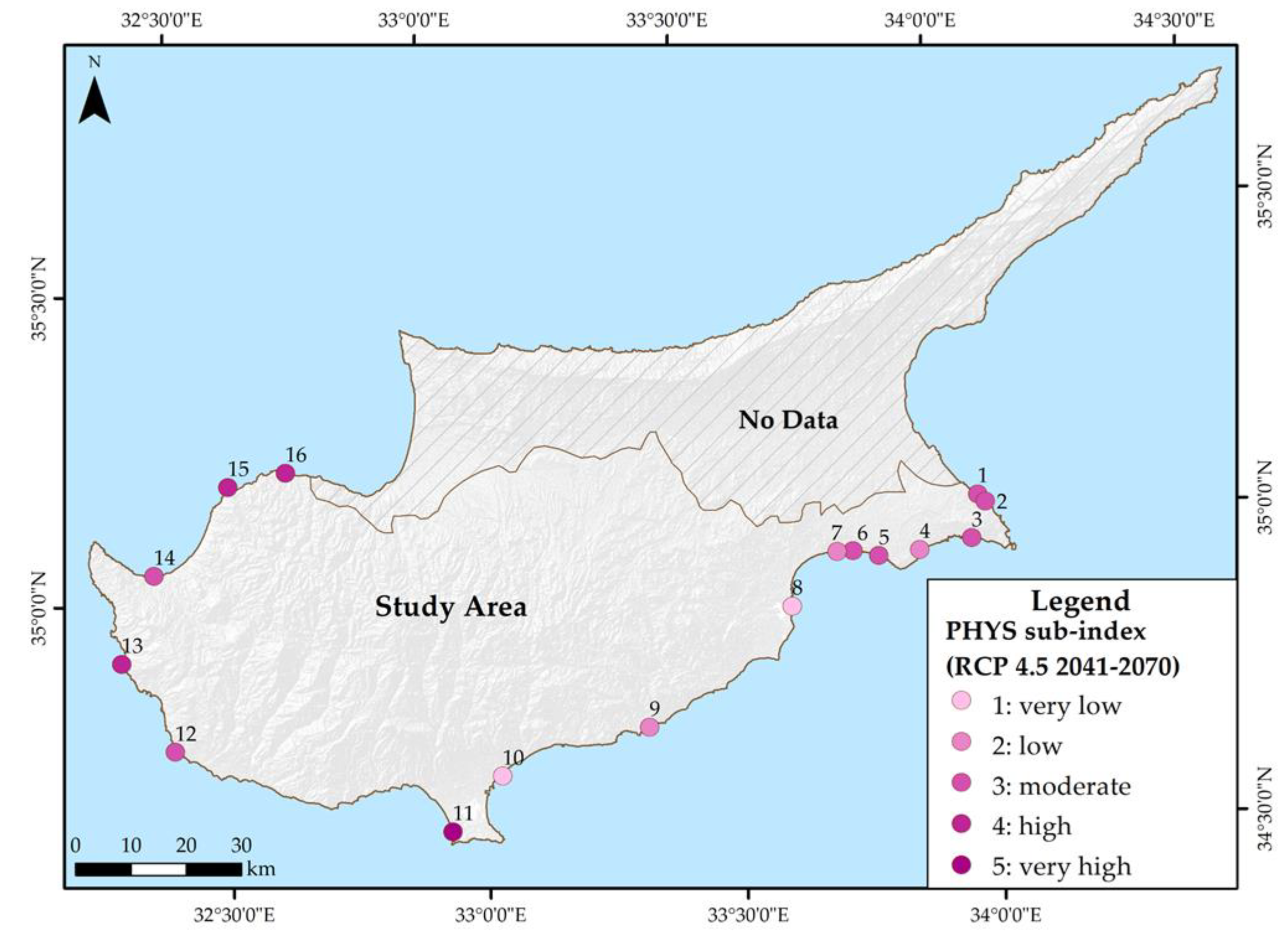
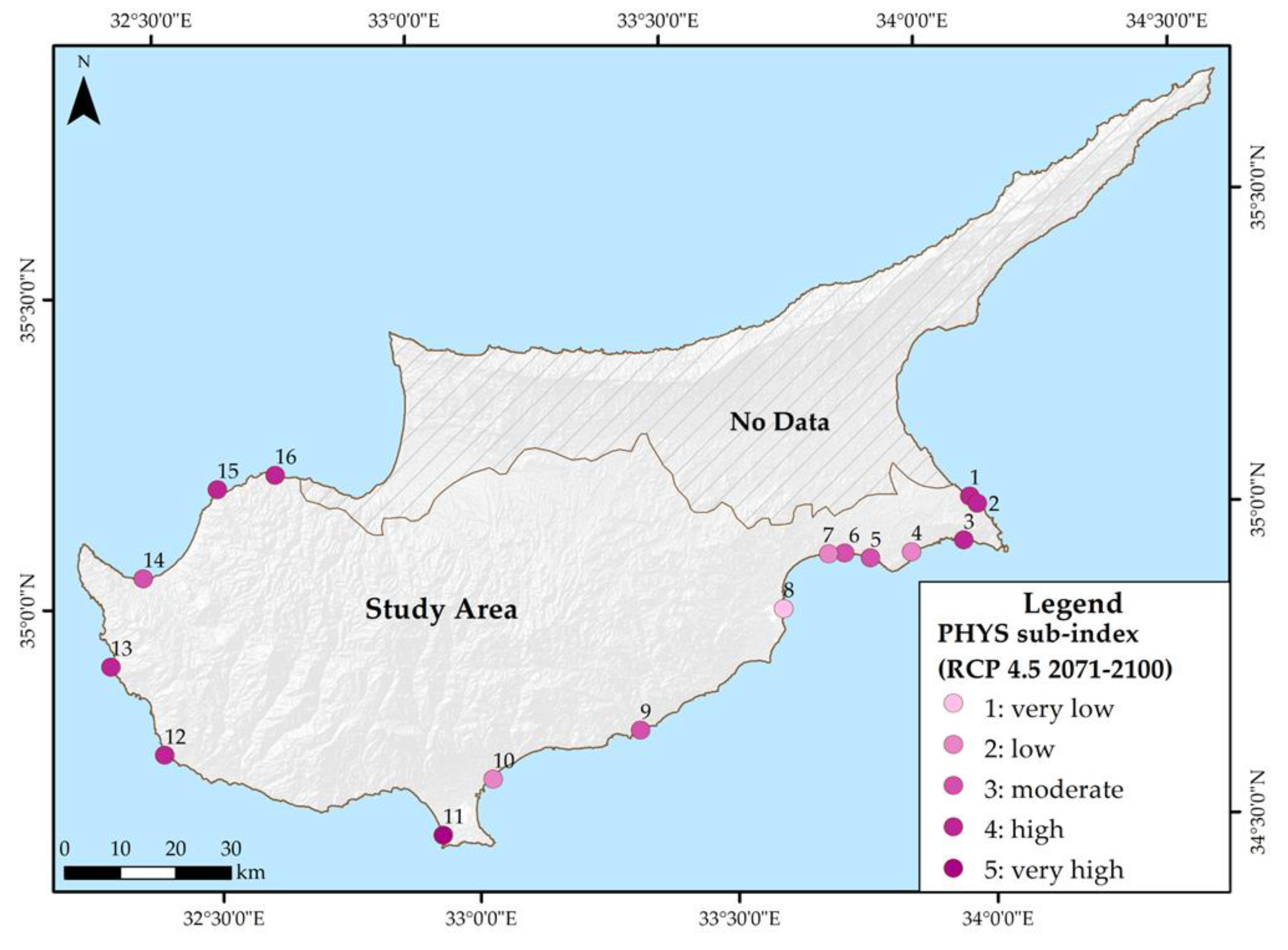

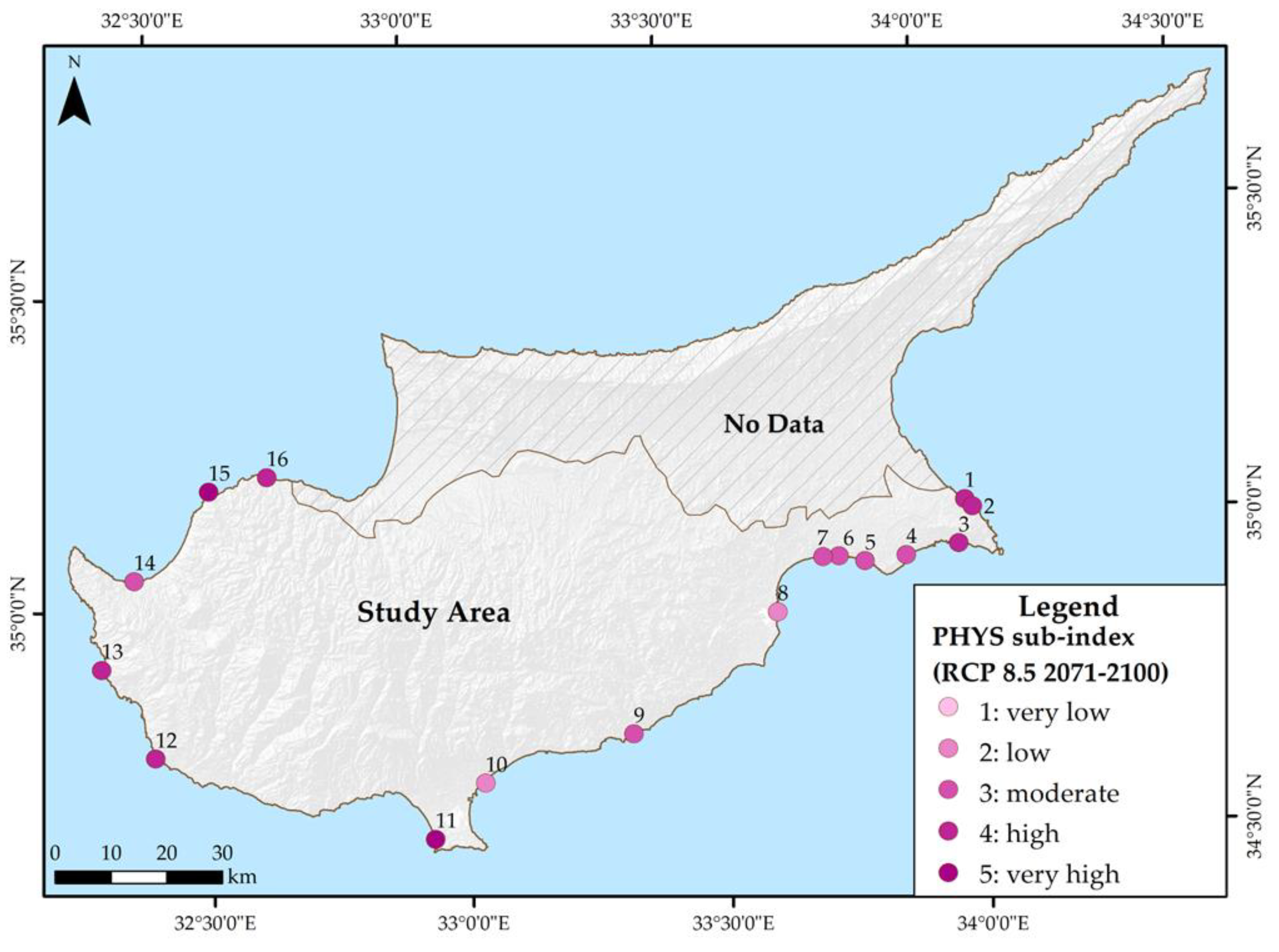
| No. | Sub-Index | Category | Variable | Units | Source |
|---|---|---|---|---|---|
| V1 | Physical | Climate | Mean wind velocity | m/s | Copernicus Climate Data Store—Product: CORDEX regional climate model data on single levels |
| V2 | Mean air temperature | °C | Copernicus Climate Data Store—Product: CORDEX regional climate model data on single levels | ||
| V3 | Mean precipitation | mm | Copernicus Climate Data Store—Product: CORDEX regional climate model data on single levels | ||
| V4 | Hydrodynamic conditions | 1-year return period extreme significant wave height | m | Copernicus Climate Data Store—Product: Ocean surface wave time series for the European coast from 1976 to 2100 derived from climate projections | |
| V5 | 50-year return period extreme significant wave height | m | Copernicus Climate Data Store—Product: Ocean surface wave time series for the European coast from 1976 to 2100 derived from climate projections | ||
| V6 | Sea level (change) | mm/year | Copernicus Climate Data Store—Product: Ocean surface wave time series for the European coast from 1976 to 2100 derived from climate projections | ||
| V7 | Geomorphology | Sediment | Type | Geological Survey Department, Ministry of Agriculture, Natural Resources and Environment | |
| V8 | Earthquake zone | I, II, III | Geological Survey Department, Ministry of Agriculture, Natural Resources and Environment | ||
| V9 | Environmental | Areas of environmental interest | Distance from areas included in the NATURA 2000 network | km | Department of Environment, Ministry of Agriculture, Natural Resources and Environment |
| V10 | Distance from aquaculture | km | Department of Environment, Ministry of Agriculture, Natural Resources and Environment | ||
| V11 | Technical | General characteristics | Harbour capacity | Number of vessels | Department of Fisheries and Marine Research, Ministry of Agriculture, Rural Development, and Environment |
| V12 | Current usage | % | Department of Fisheries and Marine Research, Ministry of Agriculture, Rural Development, and Environment | ||
| V13 | Year of construction/reconstruction | Year | Department of Fisheries and Marine Research, Ministry of Agriculture, Rural Development, and Environment and Cyprus Port Authority (CPA), Ministry of Transport, Communication and Works | ||
| V14 | Infrastructure | Utilities and facilities | Number | Department of Fisheries and Marine Research, Ministry of Agriculture, Rural Development, and Environment and Cyprus Port Authority (CPA), Ministry of Transport, Communication and Works | |
| V15 | Port layout | - | Department of Fisheries and Marine Research, Ministry of Agriculture, Rural Development, and Environment and Cyprus Port Authority (CPA), Ministry of Transport, Communication and Works | ||
| V16 | Road network condition | Category | Ministry of Transport, Communication and Works and National Open Data Portal https://www.data.gov.cy/ (accessed on 20 April 2023) | ||
| V17 | Socioeconomic | Demographics | Distance from the closest human settlement | km | National Open Data Portal https://www.data.gov.cy/ (accessed on 20 April 2023) |
| V18 | Number of inhabitants of the closest human settlement | Number | Statistical Service of Cyprus (CYSTAT) https://www.cystat.gov.cy/ (accessed on 20 April 2023) | ||
| V19 | Number of professional users | Number | Department of Fisheries and Marine Research, Ministry of Agriculture, Rural Development, and Environment | ||
| V20 | Economics | Distance from the closest port | km | National Open Data Portal https://www.data.gov.cy/ (accessed on 20 April 2023) | |
| V21 | Maintenance costs during the last 15 years | Euros | Department of Public Works, Ministry of Transport, Communication and Works |
Disclaimer/Publisher’s Note: The statements, opinions and data contained in all publications are solely those of the individual author(s) and contributor(s) and not of MDPI and/or the editor(s). MDPI and/or the editor(s) disclaim responsibility for any injury to people or property resulting from any ideas, methods, instructions or products referred to in the content. |
© 2023 by the authors. Licensee MDPI, Basel, Switzerland. This article is an open access article distributed under the terms and conditions of the Creative Commons Attribution (CC BY) license (https://creativecommons.org/licenses/by/4.0/).
Share and Cite
Chalastani, V.I.; Pantelidis, A.; Feloni, E.; Papadimitriou, A.; Tsaimou, C.N.; Nisiforou, O.; Tsoukala, V.K. Development of a Complex Vulnerability Index for Fishing Shelters—The Case of Cyprus. J. Mar. Sci. Eng. 2023, 11, 1880. https://doi.org/10.3390/jmse11101880
Chalastani VI, Pantelidis A, Feloni E, Papadimitriou A, Tsaimou CN, Nisiforou O, Tsoukala VK. Development of a Complex Vulnerability Index for Fishing Shelters—The Case of Cyprus. Journal of Marine Science and Engineering. 2023; 11(10):1880. https://doi.org/10.3390/jmse11101880
Chicago/Turabian StyleChalastani, Vasiliki I., Andreas Pantelidis, Elissavet Feloni, Andreas Papadimitriou, Christina N. Tsaimou, Olympia Nisiforou, and Vasiliki K. Tsoukala. 2023. "Development of a Complex Vulnerability Index for Fishing Shelters—The Case of Cyprus" Journal of Marine Science and Engineering 11, no. 10: 1880. https://doi.org/10.3390/jmse11101880
APA StyleChalastani, V. I., Pantelidis, A., Feloni, E., Papadimitriou, A., Tsaimou, C. N., Nisiforou, O., & Tsoukala, V. K. (2023). Development of a Complex Vulnerability Index for Fishing Shelters—The Case of Cyprus. Journal of Marine Science and Engineering, 11(10), 1880. https://doi.org/10.3390/jmse11101880








